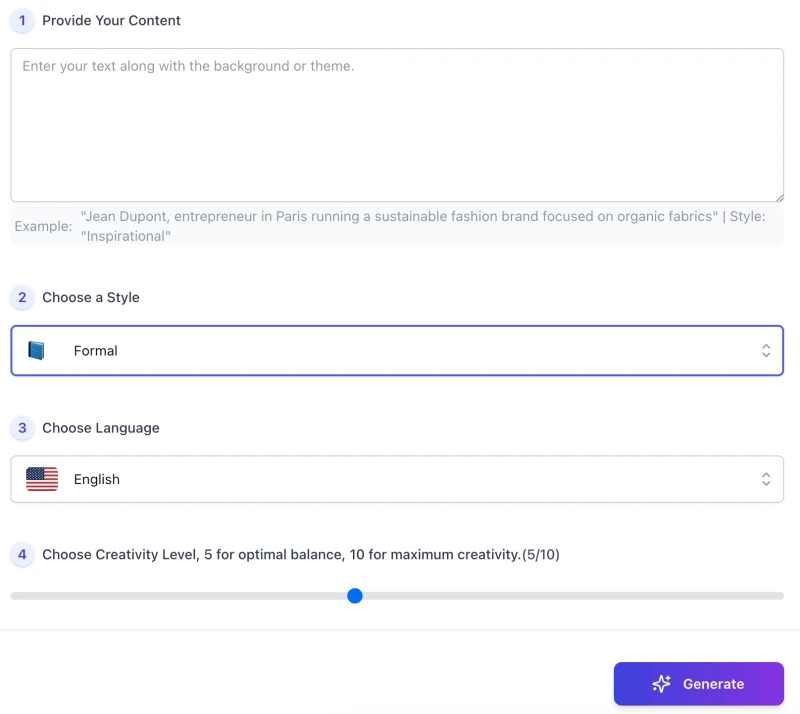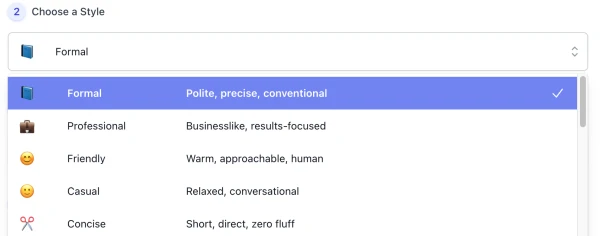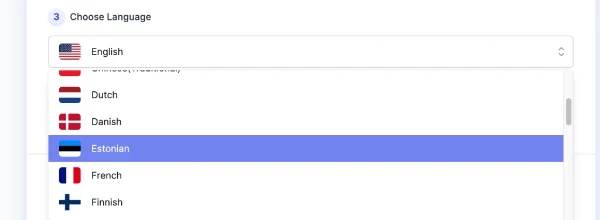Free AI Tools. No Sign-Up Required. Full Access.
AI Introduction Generator
Free online AI tool to write introductions — no sign-up, perfect for essays, blogs, and professional bios.
Combine the current tool with these other tools to work more efficiently.
AI Bio Generator
AI Introduction Paragraph Generator
AI Resume Summary Generator
AI LinkedIn Bio Generator
AI Author Bio Generator
AI Real Estate Bio Generator
AI About Us Page Generator
AI Business Description Generator
AI Product Description Writer
AI Description Generator
Discover other tools with functions and purposes similar to the one you are currently viewing.
- AI Bio Generator

- AI Introduction Paragraph Generator

- AI Author Bio Generator

- AI Essay Introduction Generator

- AI Blog Intro Generator
- AI Character Description Generator

- AI Description Generator

- AI LinkedIn Bio Generator
- AI Business Description Generator

- AI Instagram Bio Generator
- AI Resume Headline Generator

- AI Writer Generator
Discover the tools most favored and highly-rated by users on our website.
Explore more AI tools in these related categories
AI Writing tools generate, or enhance text content for various writing tasks.
AI tools that automatically create text content for your images, audio, or video from user prompts.
AI tools for creating, optimizing resumes, cover letters, and other professional documents.
This is the AIFreeBox AI Introduction Generator page — an online tool that helps you craft clear, tailored introductions for people, companies, products, and services. It works as a practical writing partner for moments when first impressions count, from professional bios to business profiles and product descriptions.
On this page, you’ll see what the tool offers: key capabilities, best use cases, step-by-step guidance, writing tips, limitations, common issues with solutions, and a detailed FAQ.
What Can AIFreeBox AI Introduction Generator Do?
The AIFreeBox AI Introduction Generator is powered by transformer-based large language models, tuned for introduction writing rather than generic text generation. Its purpose is clear: help users craft introductions that are concise, appropriate, and style-matched.
With 15 core styles (Professional, Concise, Friendly, Persuasive, Creative), ten extended variants, and support for 33 languages, the tool adapts tone and structure to suit LinkedIn bios, CV summaries, About pages, outreach emails, or product descriptions.
All outputs are grounded in user input, avoiding invented facts or exaggerated claims to ensure compliance and trust. Here, AI works as a writing coach and rapid sketch assistant, while the human remains the content owner — providing facts, choosing style, and approving the final version. This collaboration produces introductions that are polished, authentic, and verifiable.
AIFreeBox Introduction Generator vs. Generic Text Generators
Not all AI writing tools are the same. Here’s how our introduction-focused tool stands apart from generic text generators.
| 🔍 Feature | ✅ AIFreeBox AI Introduction Generator | ⚠️ Generic Text Generators |
|---|---|---|
| 🎯 Purpose | Specialized for introductions (people, companies, products, services) | Broad, unfocused outputs for any text |
| 🎨 Style Control | Single-select styles (5 core, 15 extended) with clear tone rules | Vague tone settings; inconsistent results |
| 🌐 Languages | 33 languages with attention to cultural fit | Often English-centric; mixed quality elsewhere |
| ✔️ Compliance | Grounded in user input; no invented claims or hype | May generate unverifiable or inflated statements |
| 🧩 Structure | Auto-detect subject (person/company/product) and apply intro structure | Generic paragraphs without clear intro logic |
| 📝 Output Quality | Clear, concise, style-matched introductions | Fluff-prone; off-topic or redundant details |
| 🤝 Human–AI Role | AI = coach & draft maker; user = fact owner & final reviewer | No clear collaboration model; heavy post-editing |
| ⚙️ Controls | Length/creativity guardrails; optional soft CTA | Few controls; unpredictable tone and length |
Recommended Use Cases and Who Benefits
Writing an introduction can be harder than it looks—here are seven common situations where this tool helps simplify the task.
| Use Case | Problem Solved | Who Benefits |
|---|---|---|
| LinkedIn profile summary | Difficulty turning career history into a sharp, short intro | Job seekers, freelancers |
| Outreach email opener | Weak or vague first line leading to low engagement | Sales reps, recruiters |
| Website “About” section | Overly long copy that loses reader attention | Startups, small businesses |
| Product/service one-liner | Features listed without a clear value statement | SaaS teams, e-commerce shops |
| Resume or CV objective | Generic statements that fail to stand out | Students, professionals switching careers |
| Pitch deck introduction | No concise “what/why/for whom” message | Founders, project leads |
| Multilingual adaptation | Manual rewrites create inconsistency across markets | Global teams, international marketers |
How to Create Introductions with AIFreeBox AI:
Step-by-Step Guide

Follow these simple steps to create an introduction that fits your needs. Each step is designed to be clear, practical, and easy to complete.
Step 1 — Provide Your Content
Enter the key details you want to introduce, such as a person’s background, a company’s focus, or a product’s value. The tool relies on your input, so include the facts that matter most.
Step 2 — Choose a Style

Select one of the available styles (e.g., Professional, Concise, Friendly, Humorous). The choice defines the tone and helps align the introduction with your audience.
Step 3 — Choose Language

Pick the language you need from the supported list of 33 options. The generator adapts grammar and tone for cultural relevance.
Step 4 — Adjust Creativity Level
Use the slider to set how creative the text should be. A mid-level (around 5/10) balances clarity with variety, while higher levels allow more expressive wording.
Step 5 — Generate and Review
Click Generate to produce your draft. Review the output carefully, ensuring it reflects your facts and intent before using it in your chosen context.
Step 6 — Download or Copy
Once satisfied, you can quickly Download the result as a file or Copy it to paste into your LinkedIn, CV, website, or email.
Step 7 — Report Bug (Real Human Support )

If you encounter issues, use the Report Bug button. A support team member will review your feedback promptly—your experience is taken seriously, and real people are ready to help.
Remember: the AI acts as a writing coach and sketch assistant, shaping your material into a first draft. You remain the content owner, providing the facts, selecting the style, and approving the final version—ensuring every introduction is both polished and authentic.
Practical Tips for Getting the Best Introductions
From a product manager’s perspective, introductions work best when the tool is guided with the right input and tuned to the right context. Here are some tips to help you shape outputs that match your needs.
Making the Tool Work for You
- 📝 Be clear with your facts — add concrete details like roles, dates, or product features instead of vague terms.
- 🎯 Keep the focus narrow — describe one person, company, or product at a time for sharper results.
- 🔑 Point out key highlights — mention the 2–3 facts you want readers to remember most.
- 📏 Use the creativity slider wisely — mid-level for balanced text, higher levels for more expressive output.
- 👀 Iterate when needed — if the draft misses something, add that fact and regenerate until it feels right.
Fine-Tuning Style and Context
- 👤 For personal intros — share career highlights or passions; Professional or Concise styles work well for CVs and LinkedIn.
- 🏢 For company profiles — mention mission, founding year, and value offered; Authoritative or Friendly fits About pages.
- 📦 For products or services — include features and standout benefits; Persuasive or Technical highlight credibility.
- 📬 For outreach emails — provide recipient context; Concise or Friendly helps keep it clear and approachable.
- 🌍 For multilingual use — choose from 33 languages to ensure tone and accuracy across regions.
- ⚖️ Balance truth with tone — give the facts, then let style shape how they are presented (formal, warm, or creative).
User Case Study: How It Works in Practice
Real examples show how the tool fits into everyday needs. Each case study highlights how user input, AI draft, and human refinement come together to produce a final, trustworthy introduction.
👤 Case 1 — LinkedIn Profile Summary
User Input:
“Alex Chen, data analyst with 5 years in fintech, skilled in SQL and Python, focused on turning data into business insights.”
Chosen Style: Professional
AI Draft:
“Alex Chen is a data analyst with five years of fintech experience. Skilled in SQL and Python, he specializes in transforming complex datasets into clear insights that drive business decisions.”
Human Refinement:
The user simplified wording and added a personal angle: “passionate about helping teams make data-driven choices.”
Final Result:
“Alex Chen is a data analyst with five years of fintech experience. Skilled in SQL and Python, he transforms data into clear insights that guide smarter business decisions, and is passionate about helping teams make data-driven choices.”
🏢 Case 2 — Company About Page
User Input:
“GreenFuture Energy, startup founded in 2020, develops affordable solar panels for rural communities.”
Chosen Style: Authoritative
AI Draft:
“GreenFuture Energy, founded in 2020, is dedicated to delivering affordable solar solutions for rural communities. The company focuses on innovation and accessibility in renewable energy.”
Human Refinement:
The team added location and impact metrics: “already serving 5,000 households across three regions.”
Final Result:
“Founded in 2020, GreenFuture Energy develops affordable solar panels tailored for rural communities. Already serving 5,000 households across three regions, the company advances renewable energy through innovation and accessibility.”
📦 Case 3 — Product One-Liner
User Input:
“NeuroTrack, wearable headset for focus enhancement using EEG signals, launched in 2023.”
Chosen Style: Technical
AI Draft:
“NeuroTrack is a wearable EEG headset launched in 2023 to improve focus. It measures brain signals and provides real-time feedback to support concentration.”
Human Refinement:
The user shortened the text for marketing use: “designed for students and professionals.”
Final Result:
“NeuroTrack is a 2023 EEG headset that enhances focus through real-time brain signal tracking, designed for students and professionals.”
✉️ Case 4 — Outreach Email Intro
User Input:
“SwiftHire, online recruitment platform, connects startups with vetted freelance developers.”
Chosen Style: Concise
AI Draft:
“SwiftHire is an online platform that helps startups find vetted freelance developers quickly and reliably.”
Human Refinement:
The user made it more direct for email: “helping you scale projects faster.”
Final Result:
“SwiftHire connects startups with vetted freelance developers, helping you scale projects faster and with confidence.”
These examples highlight the human–AI collaboration model: the AI drafts introductions based on facts and style, while the user refines details and approves the final version. This ensures every introduction is polished, authentic, and tailored to its purpose.
Style System Overview
The AI Introduction Generator supports a range of styles. Each one changes the tone of your introduction, helping you match the right voice to the right audience. It also adapts grammar and tone across 33 languages with attention to cultural fit, going beyond direct translation to keep introductions natural and context-aware.
- 💼 Professional — Clear, result-focused, businesslike tone.
- ✂️ Concise — Short and direct, no extra words.
- 😊 Friendly — Warm, approachable, human-centered.
- 🎯 Persuasive — Benefit-first, encouraging soft action.
- 🎨 Creative — Fresh imagery and engaging expressions.
- 🌟 Inspirational — Uplifting, positive, future-facing tone.
- 🤝 Empathetic — Supportive, understanding, people-first.
- 😄 Humorous — Light, safe humor to add personality.
- 🎓 Academic — Scholarly, careful, with precise language.
- 🧪 Technical — Accurate, detail-rich, focused on facts.
- ⚖️ Neutral — Balanced and objective, no bias or hype.
- 💎 Luxury — Refined, elegant, premium in tone.
- ✅ Authoritative — Confident and definitive, clear guidance.
Limitations and How to Handle Them
Like any tool, the AI Introduction Generator has boundaries. Here are seven common issues you might face and practical ways to address them.
| ⚠️ Limitation | Why It Happens | How to Solve |
|---|---|---|
| Generic output | Input is too vague or lacks key facts | Add 2–3 specific details and regenerate |
| Style feels inconsistent | Chosen style not clear or mixed subjects | Select one style only; keep content focused |
| Excess length | Too many details in input or high creativity level | Trim input; lower creativity slider |
| Overly simple draft | Minimal information provided | Include role, achievements, or main value points |
| Language mismatch | Wrong language option selected | Check the dropdown and choose correct language |
| Not fully culturally aligned | AI adapts tone, but local nuance is not automatic | Add region-specific cues or adjust wording manually |
| Needs human polish | AI provides a draft, not a final version | Review, edit tone, and approve before use |
FAQs
Is the AI Introduction Generator free to use?
Yes, it is free to use online with no registration required. You can generate as many drafts as you need without limits.
Will my input be saved or shared publicly?
No. Your input is not stored, not shared, and not used for public display. Every draft is generated in real time and remains private to you.
What types of introductions can this tool create?
It is designed for short introductions such as LinkedIn summaries, CV objectives, company About sections, outreach email openers, and product/service one-liners. It is not meant for long essays or unrelated content.
How accurate are the generated results?
The tool organizes and rephrases the information you provide. It does not invent achievements or guarantees. Accuracy depends on the quality of the details you enter.
How should I choose the right style?
Select the style that matches your audience and context. For example, use Professional for CVs, Concise for email, or Friendly for personal bios. You remain the final decision-maker on tone and wording.
Can I use the text directly without editing?
It is recommended to review and adjust the draft before use. AI provides a starting point, but you add the final touches to ensure it fits your purpose and voice.
Does the tool support multiple languages?
Yes, it supports 33 languages. While the system adapts grammar and tone, cultural nuances may still require manual adjustment by you.
What if the generated text feels too generic?
Add more specific facts such as achievements, metrics, or audience details, then regenerate. The more precise the input, the more tailored the draft.
Who is responsible for the final output?
AI acts as a writing coach and draft assistant, while you remain the content owner. You decide what facts to include, select the style, and approve the final version.
Creator’s Note
The AI Introduction Generator was built with a simple idea: writing an introduction should not feel overwhelming. At the same time, it should never be left entirely to automation.
AI here is not a replacement for your judgment — it is a supporter that helps you start faster, organize your thoughts, and see different style options clearly.
Every draft the tool creates is only a beginning. The real value comes when you, as the content owner, decide what facts matter, adjust tone, and approve the final version. This partnership ensures that the result is not only polished but also authentic to you, your company, or your product.
My hope is that this tool gives you a reliable assistant for introductions, while keeping you in control of the message that represents you. Clear, credible, and context-aware — that is the balance we aim for together.
2025-10-17
💡 Try it out now — free, online, and ready when you are.
Start strong — let AI craft clear, engaging, and tailored introductions that capture attention, set the tone, and make every first impression count.